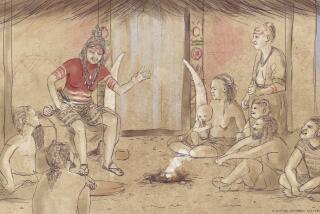Rib from Joan of Arc said to be fake
- Share via
A rib bone supposedly found at the site where French heroine Joan of Arc was burned at the stake is actually that of an Egyptian mummy, according to researchers who used high-tech science to expose the fake.
The bone, a piece of cloth and a cat femur were said to have been recovered after the 19-year-old was burned in 1431 in the town of Rouen. In 1909 -- the year Joan of Arc was beatified -- scientists declared it “highly probable” that the relics were hers.
But starting last year, 20 researchers from France, Switzerland and the West African country of Benin took another look. Even they were surprised to find the rib bone came from an Egyptian mummy. Their best guess is that the fake was cooked up in the 19th century, perhaps to boost the process of Joan of Arc’s beatification, according to a report this week in the journal Nature. She was canonized as a saint in 1920 by the Roman Catholic Church.
In medieval times and later, powdered mummy remains were used as medicine “to treat stomach ailments, long or painful periods, all blood problems,” said Philippe Charlier, who headed the research team.
The team’s assumption is that a 19th-century apothecary transformed “these remains of an Egyptian mummy into a fake relic, or fake historic remains, of Joan of Arc,” he said.
Now the mystery is why?
“Probably not for money,” Charlier said. “Perhaps it was for religious reasons. Perhaps it was created to increase the importance of the process of beatification in 1909.”
Tests dated the rib bone to between the 7th and 3rd centuries BC, he said. The cat bone dated from the same period and also was mummified. The researchers also found pine pollen, probably from resin used in Egyptian embalming, he said.
Joan of Arc was tried for heresy and witchcraft and executed after leading the French to several victories over the English during the Hundred Years War, notably in Orleans, south of Paris.
More to Read
Sign up for Essential California
The most important California stories and recommendations in your inbox every morning.
You may occasionally receive promotional content from the Los Angeles Times.










